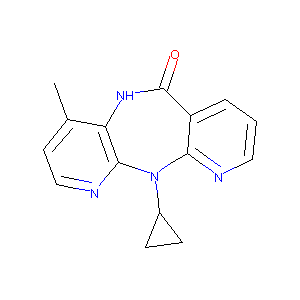| 1 |
ClinicalTrials.gov (NCT00355719) Study to Evaluate the Influence of Nevirapine to Atazanavir in Steady State Equilibrium in HIV Patients
|
| 2 |
Approved antiretroviral drugs. Antiretroviral Drugs. Company report of AVERT. 2009.
|
| 3 |
Natural products as sources of new drugs over the last 25 years. J Nat Prod. 2007 Mar;70(3):461-77.
|
| 4 |
Nevirapine restores androgen signaling in hormone-refractory human prostate carcinoma cells both in vitro and in vivo. Prostate. 2009 May 15;69(7):744-54. doi: 10.1002/pros.20923.
|
| 5 |
Reverse transcriptase inhibitors alter uncoupling protein-1 and mitochondrial biogenesis in brown adipocytes. Antivir Ther. 2005;10(4):515-26.
|
| 6 |
HIV-1 reverse transcriptase complex with DNA and nevirapine reveals non-nucleoside inhibition mechanism.Nat Struct Mol Biol.2012 Jan 22;19(2):253-9.
|
| 7 |
Human intestinal transporter database: QSAR modeling and virtual profiling of drug uptake, efflux and interactions. Pharm Res. 2013 Apr;30(4):996-1007.
|
| 8 |
Characterization of the in vitro biotransformation of the HIV-1 reverse transcriptase inhibitor nevirapine by human hepatic cytochromes P-450. Drug Metab Dispos. 1999 Dec;27(12):1488-95.
|
| 9 |
Substrates, inducers, inhibitors and structure-activity relationships of human Cytochrome P450 2C9 and implications in drug development. Curr Med Chem. 2009;16(27):3480-675.
|
| 10 |
Helices F-G are important for the substrate specificities of CYP3A7. Drug Metab Dispos. 2007 Mar;35(3):484-92.
|
| 11 |
Inhibition of human cytochrome P450 isoforms by nonnucleoside reverse transcriptase inhibitors. J Clin Pharmacol. 2001 Jan;41(1):85-91.
|
| 12 |
RAT CYP3A and CYP2B1/2 were not associated with nevirapine-induced hepatotoxicity. Methods Find Exp Clin Pharmacol. 2006 Sep;28(7):423-31.
|
| 13 |
Bioactivation of nevirapine to a reactive quinone methide: implications for liver injury. Chem Res Toxicol. 2012 Aug 20;25(8):1708-19. doi: 10.1021/tx300172s. Epub 2012 Jul 26.
|
| 14 |
Transcriptional profiling suggests that Nevirapine and Ritonavir cause drug induced liver injury through distinct mechanisms in primary human hepatocytes. Chem Biol Interact. 2016 Aug 5;255:31-44.
|
| 15 |
An in vitro coculture system of human peripheral blood mononuclear cells with hepatocellular carcinoma-derived cells for predicting drug-induced liver injury. Arch Toxicol. 2021 Jan;95(1):149-168. doi: 10.1007/s00204-020-02882-4. Epub 2020 Aug 20.
|
| 16 |
Reverse transcriptase inhibitors down-regulate cell proliferation in vitro and in vivo and restore thyrotropin signaling and iodine uptake in human thyroid anaplastic carcinoma. J Clin Endocrinol Metab. 2005 Oct;90(10):5663-71. doi: 10.1210/jc.2005-0367. Epub 2005 Jul 19.
|
| 17 |
Identification of danger signals in nevirapine-induced skin rash. Chem Res Toxicol. 2013 Sep 16;26(9):1378-83. doi: 10.1021/tx400232s. Epub 2013 Aug 30.
|
| 18 |
Nevirapine increases high-density lipoprotein cholesterol concentration by stimulation of apolipoprotein A-I production. Arterioscler Thromb Vasc Biol. 2009 Sep;29(9):1336-41. doi: 10.1161/ATVBAHA.109.192088. Epub 2009 Aug 10.
|
| 19 |
Binding of anti-HIV drugs to human serum albumin. IUBMB Life. 2004 Oct;56(10):609-14. doi: 10.1080/15216540400016286.
|
| 20 |
Effects of nevirapine and efavirenz on human adipocyte differentiation, gene expression, and release of adipokines and cytokines. Antiviral Res. 2011 Aug;91(2):112-9. doi: 10.1016/j.antiviral.2011.04.018. Epub 2011 May 17.
|
| 21 |
Different Reactive Metabolites of Nevirapine Require Distinct Glutathione S-Transferase Isoforms for Bioinactivation. Chem Res Toxicol. 2016 Dec 19;29(12):2136-2144. doi: 10.1021/acs.chemrestox.6b00250. Epub 2016 Nov 28.
|
| 22 |
Clinical Pharmacogenetics Implementation Consortium (CPIC) Guideline for UGT1A1 and Atazanavir Prescribing. Clin Pharmacol Ther. 2016 Apr;99(4):363-9. doi: 10.1002/cpt.269. Epub 2015 Nov 9.
|
| 23 |
Robustness testing and optimization of an adverse outcome pathway on cholestatic liver injury. Arch Toxicol. 2020 Apr;94(4):1151-1172. doi: 10.1007/s00204-020-02691-9. Epub 2020 Mar 10.
|
| 24 |
Hollow-fiber unit evaluation of a new human immunodeficiency virus type 1 protease inhibitor, BMS-232632, for determination of the linked pharmacod... J Infect Dis. 2001 Apr 1;183(7):1126-9.
|
| 25 |
Atazanavir: effects on P-glycoprotein transport and CYP3A metabolism in vitro. Drug Metab Dispos. 2005 Jun;33(6):764-70.
|
| 26 |
In vitro inhibition of UDP glucuronosyltransferases by atazanavir and other HIV protease inhibitors and the relationship of this property to in vivo bilirubin glucuronidation. Drug Metab Dispos. 2005 Nov;33(11):1729-39.
|
| 27 |
Atazanavir for the treatment of human immunodeficiency virus infection. Pharmacotherapy. 2004 Dec;24(12):1732-47.
|
| 28 |
Early identification of clinically relevant drug interactions with the human bile salt export pump (BSEP/ABCB11). Toxicol Sci. 2013 Dec;136(2):328-43.
|
| 29 |
Heme oxygenase-1-derived bilirubin counteracts HIV protease inhibitor-mediated endothelial cell dysfunction. Free Radic Biol Med. 2016 May;94:218-29. doi: 10.1016/j.freeradbiomed.2016.03.003. Epub 2016 Mar 8.
|
| 30 |
Some HIV antiretrovirals increase oxidative stress and alter chemokine, cytokine or adiponectin production in human adipocytes and macrophages. Antivir Ther. 2007;12(4):489-500.
|
| 31 |
Interactions of protease inhibitors atazanavir and ritonavir with ABCB1, ABCG2, and ABCC2 transporters: Effect on transplacental disposition in rats. Reprod Toxicol. 2018 Aug;79:57-65. doi: 10.1016/j.reprotox.2018.05.008. Epub 2018 May 30.
|
|
|
|
|
|
|


